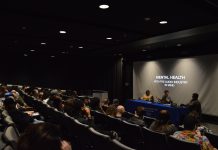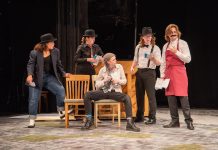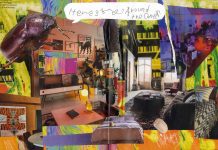
On Wednesday, Nov.7 at 7 p.m. in the Winifred Moore Auditorium approximately 50 people attended Alex Buono’s lecture on “Canon Cinema.” Buono is the director of photography for the popular television series, “Saturday Night Live.”
“I’m hoping to convince still photographers to just take the plunge and hit that record button and try it,” Buono said. “For students who are just starting to shoot video, I want to try to teach them some very simple ways to make their video easily look better, so they don’t get discouraged.”
Buono’s lecture discussed several cameras and shooting styles that he often uses to produce movies, television series and still images for many productions. He thoroughly explained the shooting styles of slow motion and time lapse. Slow motion and time lapse basically are sequences that a camera captures at specific rates. The ending shot is either in a slower time frame or sped up. For example, in the movie “The Matrix” when characters dodged bullets or were captured in fighting moves in thin air.
“I hope they got a lot of information about a working professional who’s doing video for a big television program,” said Bill Barrett, Webster photography professor and director of the May Gallery. Barrett was responsible for bringing Buono to Webster.
Buono said he does not always specifically plan some of his work, but he will try new things at any given moment. For example, a time lapse shot used on SNL of the inside a taxi cab with a foucs on the meter, was an experimental shot. After post- production, SNL loved the shot and used it in the introduction of the show.
“It was good for me, to get a perspective on that particular show’s workflow and what the production is like,” said Christopher Phillips, a Webster alumni.
Buono did not begin his career on SNL. He began as a camera assistant, working for free while he practiced his shooting styles and film work. As an assistant, he would travel with the equipment and clean it until the completion of the movie he was assisting with. He was eventually offered the chance to help film a low budget film in North Carolina, done by producer Lisa Ruffler. Ruffler loved his personality and ambition, which led her to offer him the opportunity to join her in New York to help on SNL.
“Literally, there was this connection that I made with this producer, ‘cause she liked me,” Buono said. “It wasn’t an agent or it wasn’t somebody that saw my reel, or not somebody saw something that I shot.”
Buono listed four pieces of advice for students:
1) The most valuable thing you are going to get out of film school is networking through your fellow students and friends. That’s way more important than any other thing you’re going to learn here. Those are your future collaborators, bosses, employees, helpers, and your crew.
2) You need something that is going to pay your bills. Doesn’t matter what it is, some skill that you have that can pay your bills while you’re working at your film-making career. I was a camera assistant; I didn’t want to be a career camera assistant. I just did it to pay the bills. It paid the bills while I was practicing and practicing, working for free.
3) Be ready to work for free. Work for free for a long time, because that’s what it’s going to take. No one’s going to pay you a nice fat salary the minute you graduate because you have a film degree.
4) Have it in the back of your mind that it might take you 10 years. Not everybody gets to be Paul Thomas Anderson on their first film, Wes Anderson on their first film, John Singleton on their first film. That’s okay, most people don’t. Most people, you go out there, it’s not very good and you make another film and it’s a little better. Make another film and it’s even better. But that’s the kind of work that it is, just give yourself a long-term goal. So if you can survive long enough, you can make it.
Buono answered questions and talked to students after his presentation.
“Hopefully with some of the little tips that I was able to show people tonight, their stuff will immediately look better and that will give them the inspiration to keep trying,” Buono said.



